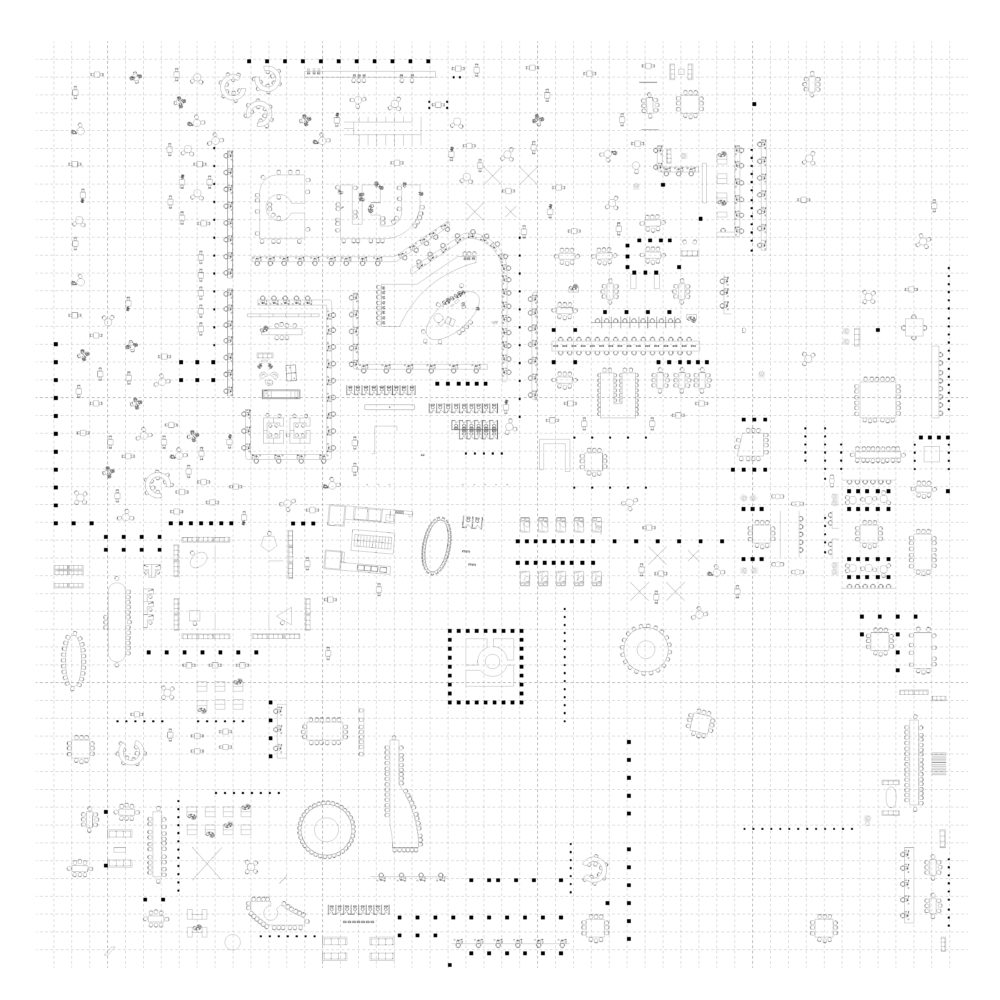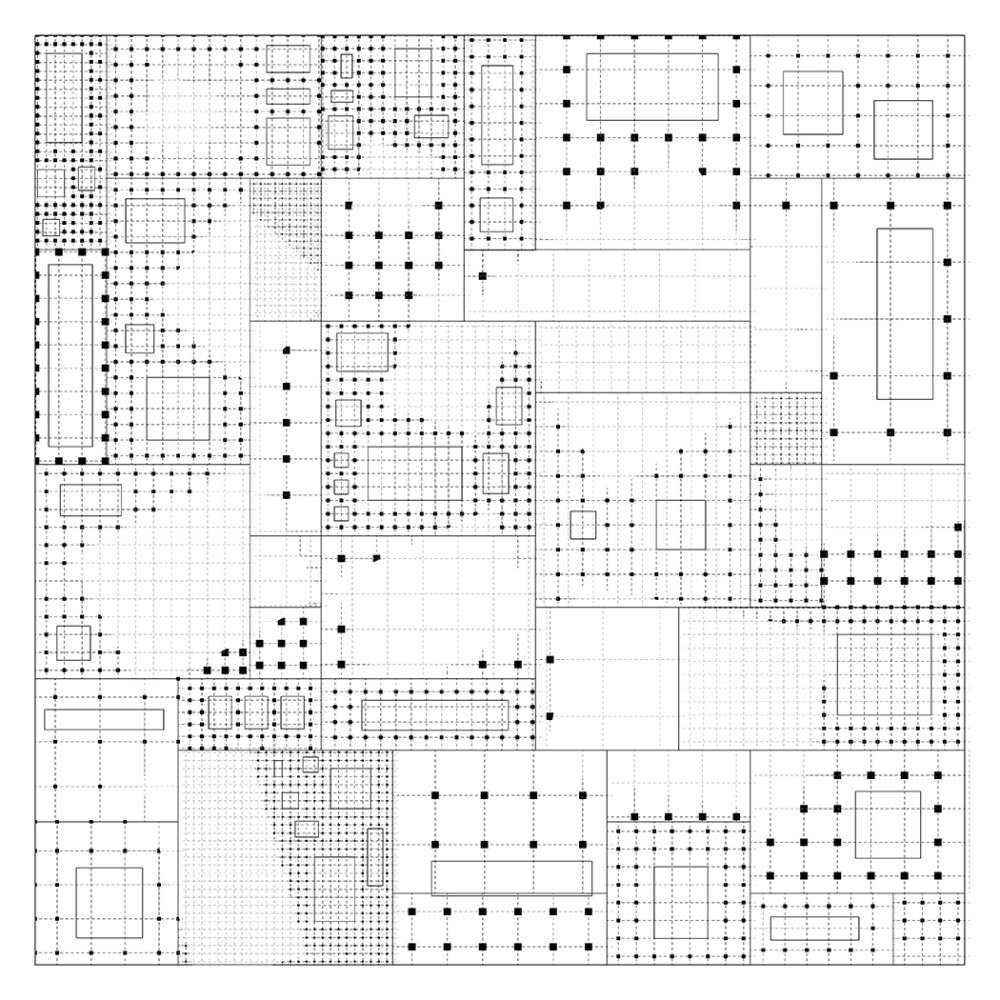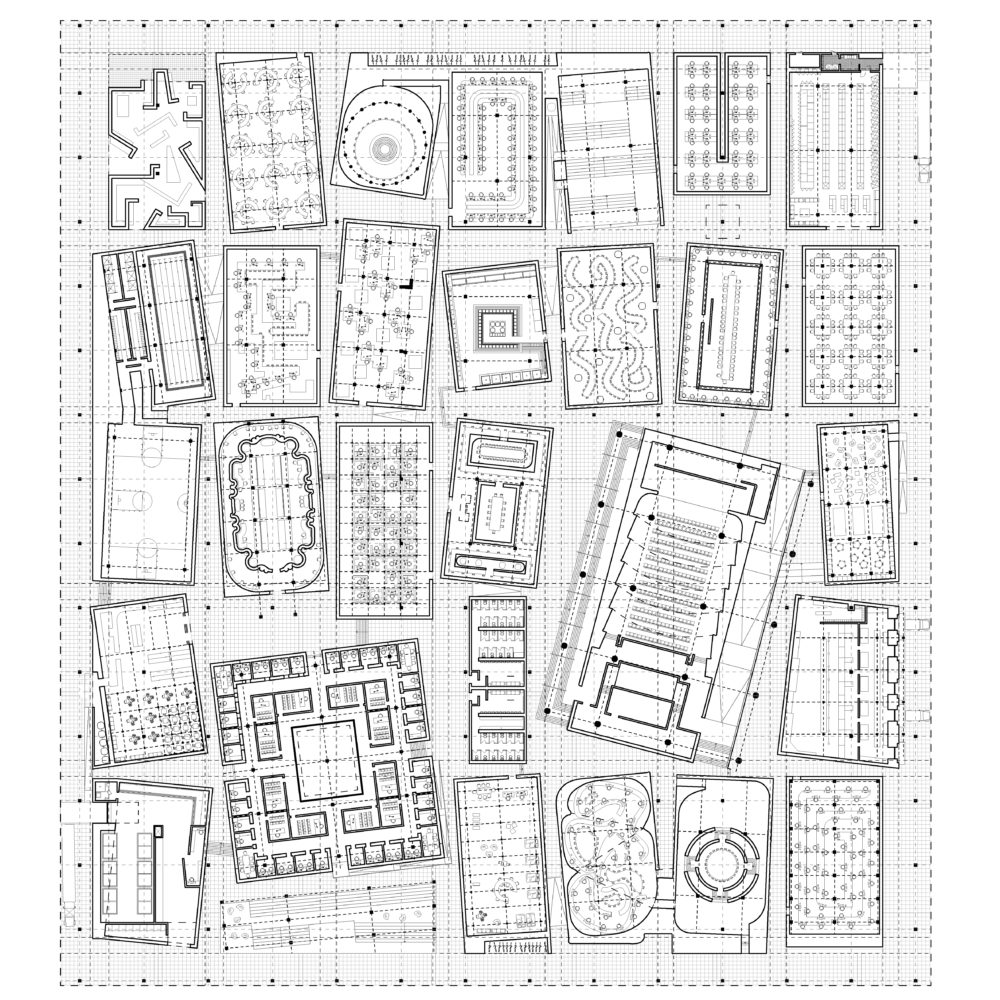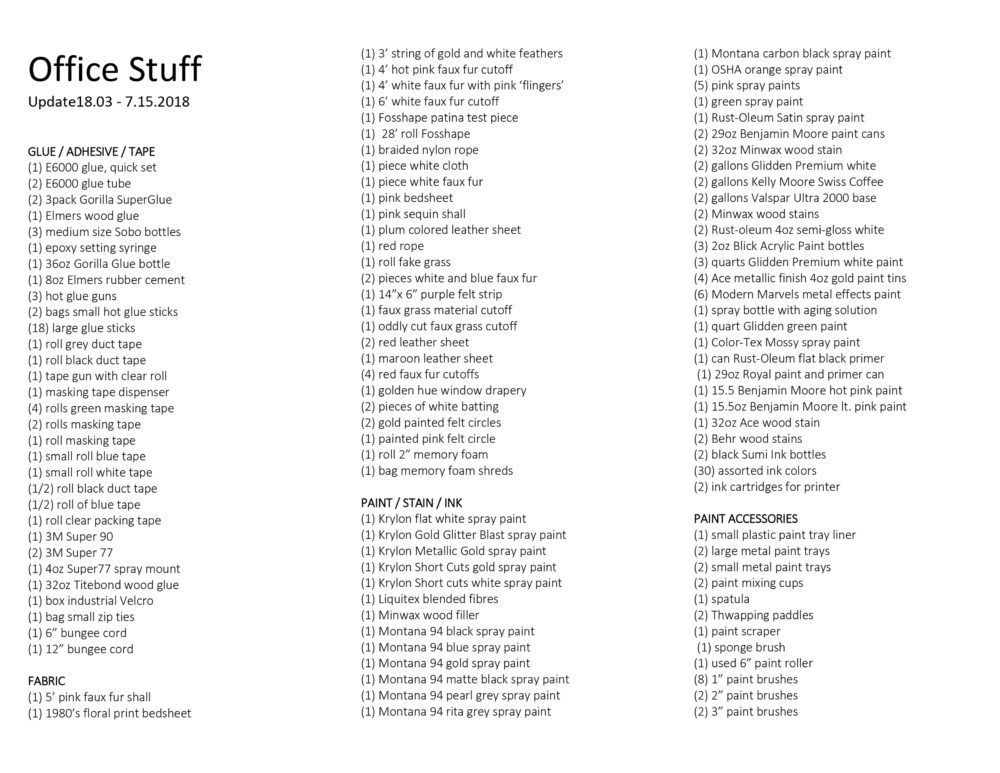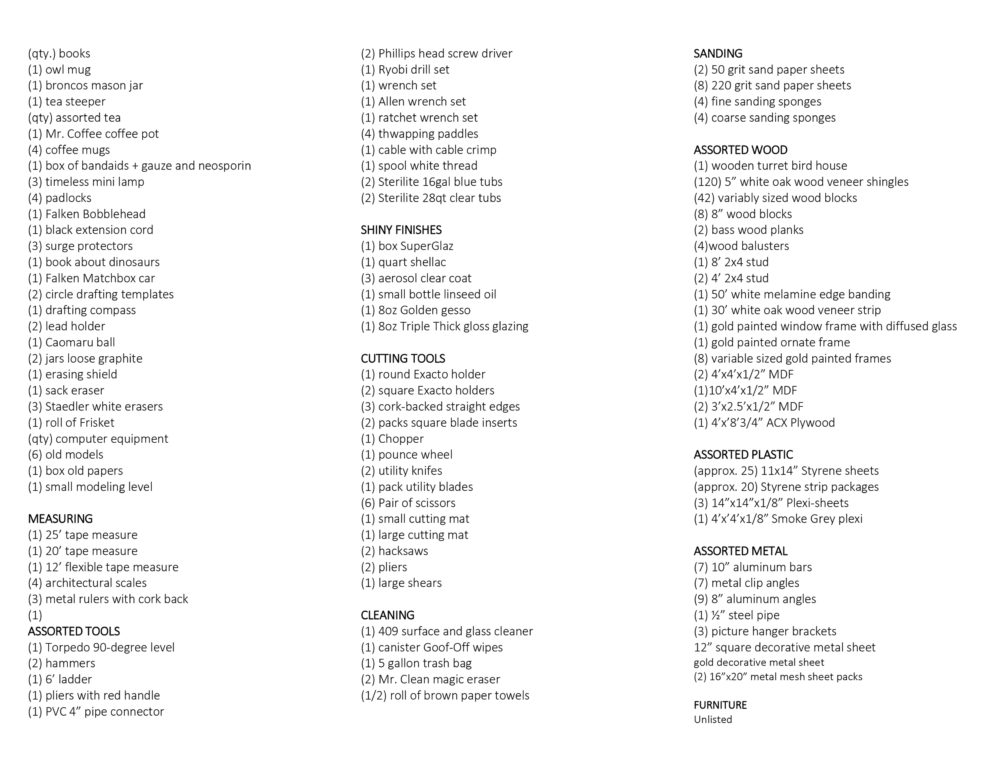Maybe it’s because we are conditioned by a canon of architecture with a history of categorized elements such as walls, floors, columns, facades, roofs, and so forth that to encounter a discussion on stuff seems oddly uncomfortable. Yet, perhaps what this suggests is an architectural imaginary underpinned by logistics, material accumulation, and provisional informality.
Stewart Brand alluded to this in his 1994 essay, “Shearing Layers”, in which he advanced Francis Duffy’s four S’s of buildings (Shell, Services, Scenery, and Set) into six. Allocated in a descending timescale, Brand’s first five S’s are Site, Structure, Skin, Services, and Space Plan (can you guess the sixth?). The longest duration, suggests Brand, is Site, noted as the geographic location or legally defined lot which is “eternal”. Structure, as the foundation and load bearing elements, is “perilous and expensive to change. These are the building, and last 30 to 300 hundred years.”Skin changes approximately every 20 years while Services such as wiring, plumbing, HVAC, and mechanical parts become outdated or require repair every seven to 15 years. Space Plan, especially in commercial settings, includes interior walls, doors, ceilings and elements that “change every three years or so, whereas exceptionally quite homes might wait thirty years.” Lastly, we arrive at the sixth S, Stuff, which Brand describes as all the things that switch around hourly, daily, or monthly like chairs, desks, tables, staplers, phones, pictures, pillows, plates, papers, and so on.
While Brand’s descending timescale gives examples in relation to a building’s use, it does little to qualify stuff as a logistical or organizational metric. In the following triptych I reflect on stuff as a material condition of office management and spatial organization as learned through my office, Endemic Architecture. In keeping with Duffy and Brand’s S’s, the following will be told through terms affiliated with Stuff; Sort, Scatter, and Shuffle.
SORT: Logistical and Irrational Material of an Office
While the end result of an architectural process may be a building, an exhibition, an installation, a drawing, a model, an animation, a publication or any number of things, it takes stuff to produce it. If you have ever seen an architect’s office – or studio for that matter – you already know this. Yet rarely do you display the equipment, gear, scraps, tape, glue, tweezers, empty spray paint cans, keyboard, or mouse on the wall for final review. You show the designed project instead. As a collection of background materials with the utmost necessity in the act of making, stuff is subject to the contradictory definitions of being both logistical and irrational. As the material basis through which complex operations, economic imperatives, and coordination of an intended outcome is managed, stuff is a logistical ensemble calibrated by what you have and what you need to get to do any work in the first place. How many times have you freaked out because you ran out of _________ at 2am!? Stuff is the logistical basis of material acquisition / inheritance, economic constraints, subjective sensibilities, and physical or electronic storage capacity.
Precisely because stuff is a logistical medium, it contradictorily becomes a source of irrational collecting and careful sorting. Whether it is digital or physical accumulation, we often sort it, store it, save it, label it, and organize our architectural possessions as an ever-present, accessible archive at the ready for the next pursuit. In my office, for example, I tend to a list of equipment, materials, supplies, accessories, gear, things, tools, fabrics, paper, paint, and so on used in the production of past and current projects so that as new ones come in I am logistically readied. Some of this stuff is commonplace to any office such as furniture, keyboards, project binders, or felt tip pens. But other items are more uniquely related to individual projects such as custom pink-dyed faux fur, Modern Marvels Patina Aging Solution, or custom-made ‘thwapping’ paddles once used to achieve a particular plaster texture. All of this sorting and listing is mildly irrational behavior – how many future projects will I really need my thwapping paddles for? But as the materially logistical underpinning for much of the work I currently do, it’s also the material basis for resource, time, and economic management.
SCATTER: An Appearance of Fullness & Institutional Imperatives
Stuff is an unsuspecting source for spatial ordering that is distinct from that described in Sort. As Venturi reminds us, “a valid order accommodates the circumstantial contradictions of a complex reality. It accommodates as well as imposes. It thereby admits control and spontaneity, correctness and ease – improvisation within the whole.” This is certainly true at the scale of institutions, especially for architecture schools that are stuffed with operational materials requisite to educational operations. The spatial politics of such operational materiality is deeply important to the institution, yet there is often the imperative that it be absorbed into the spatial logics of the physical context. These institutional materials are distinct from those outlined by Brand. We are not only talking about your desks, lamps, or chairs, but also materials found in re-use depots, facilities management equipment, tool and machine rentals, bike storage, café products, faculty mailboxes, items at shipping & receiving, NAAB accreditation project storage, trash cans, spaces for leisure and socializing, and so forth.
At California College of the Arts, a 73,470 square foot Back Lot behind the college is where much of this institutional stuff is housed. In September 2017 this almost 2 acre Back Lot was host to an exhibition curated by then CCA Architecture Dean Jonathan Massey showcasing full scale architectural prototypes with the roll of exhibition designer played by yours truly. This was an atypical site for an exhibition design. At once display venue, work yard, and social space, the Back Lot is equipped with at the time ten, (now 12) 40’-0” shipping containers for storage, a material reuse depot, a facilities management outpost, a welding and casting station, forklifts, an Airstream trailer, picnic tables, benches, umbrellas, portable basketball hoops, trees in planter boxes, trash cans, a working garden, hammocks, and random debris from art-making processes. Rather than impose a singular order, this operational and social infrastructure was understood in the manner of confetti; dispersed, informal, and both accommodating and imposing as an organizational strategy with a scattered material quality. Scattering, as confetti does, easily accommodates material additions and subtractions to a pre-existing diversity of materials and subjects without disrupting the perceptions or operations of order. As a virtue of scattering, confetti sponsors circumstantial improvisations within an otherwise known landscape while giving an appearance of fullness and continuity to large areas. Thus, scattering the Back Lot components across the pavement as though they were tossed confetti created a loose yet carefully studied frame for the prototypes on display while painted super-graphic confetti discs, ribbons, bands, and shapes cued visitors to move, stand, and look in particular ways. Calling this project Confetti Urbanism, the institutional and operational stuff of the college became the scattered materials of an urban landscape within a confetti super-graphic accommodating social, eventful, operational, and institutional obligations.
SHUFFLE: Interior Provincialisms & Expanding Floors
Returning to our introductory protagonists, Francis Duffy and Stewart Brand whose literature was primarily concerned with workplace environments, a recent series of drawings completed in my office considered what this might mean in the context of a Silicon Valley ‘tech building’ where leisure, work, amenity, research & development, and collaboration poses contemporary challenges Brand’s scale of stuff . These “Tech Plans” do not fuss over form – they are all square (and therefore not “Typical”) and emphasize relationships between internal Structure and stuff as the primary ensemble of workplace environments in the tech industry. The intermingling between these two encourages a shuffled spatial quality characterized by what I call spatial provincialisms. Whereas ‘scattering’ has more to do with the spreading of otherwise unrelated materials within an indeterminate edge, ‘shuffling’ is precisely bound at its perimeter with an interior informality that is something between a loose-fit plan and a free plan. In a shuffled plan, proximity of variable relationships create interiors within interiors and stage episodic social and spatial in-between spaces; provincialisms. In a shuffled plan, Brand’s definition of stuff grows dramatically beyond the scale of furniture to include walls, defined rooms, stairs, and even short-stay housing, grocery stores, laundromats and gyms – once standalone amenities of ‘Main Street’ are now absorbed into the interior world of the Tech Plan - as these become the biggest stuff within an ever-expanding room. Free plan becomes confused by variable-density column grids, corridors and enfilade conflate into each other, redundant enclosures make rooms in the middle of corridors and visa versa, equipment densifies as leisure expands, and programmatic hybridity maximizes amenity creating provincial - and provisional - spatial pockets.
Some Concluding Affiliations
Perhaps any initial discomfort, if you had any at all, at the idea of enfolding stuff into our disciplinary lexicon has by now subsided. I hope we can agree to the term’s merits as a source for an architectural imaginary that opens conceptual and material territory beyond any perceived limitations of canonical definitions or disciplinary brackets. Stuff is a logistical medium and a source of irrational collecting, the material constituents of an ordering logic ideally suited to accommodating circumstantial and temporary contradictions, and fosters interior spatial provincialisms that confuse scalar differentiations between program, furniture, elements, and amenity in increasingly large buildings. While Sort, Scatter, and Shuffle are terms affiliated with the management or recent work of my office, it begs the question, what are other affiliated terms through which we might further expand or re-consider our inherited vocabulary in relation to stuff? For the sake of consistency, these might include: Spread, Sow, Sprinkle, Scramble, Spark, Snippet, Shred, Shard, Shatter, Shower, Spill, Shed, Slough, Sluff, Strew, Sizzle, Squirm… Perhaps what we might learn from stuff is that by enlisting its affiliated terms (even those that do not begin with “s”) as disciplinary qualifiers, we enroll conceptual, material, and logistical processes as means for encouraging organizational strategies that favor provisional informality, happenstance accommodation, and material accumulation.
Clark Thenhaus is a licensed architect and founding director of Endemic Architecture, and an Assistant Professor at the California College of the Arts in San Francisco. Thenhaus’ work has been widely exhibited, including at Parsons The New School gallery as a winner of the 2015 Architectural League Prize, A+D Museum, Jai & Jai Gallery, Yale School Of Architecture, Harvard Graduate School of Design, the University of Calgary, the Royal Melbourne Institute of Technology, and AIA San Francisco among others. Thenhaus has delivered numerous lectures on his work at field-leading educational institutions and has had work published in the Wall Street Journal, Possible Mediums, Project Journal, Journal of Architectural Education (JAE), Architects Newspaper, Architect Magazine, and Thresholds Journal among others. Thenhaus’ work has received numerous awards, including most recently the Architects Newspaper Best of Design Award for Best Public Landscape of 2017.


